Water World
Water World is a massive water park located in Federal Heights, Colorado, about 10 miles north of downtown Denver. It is an unusual water park in that it is owned and operated by the Hyland Hills Park and Recreation District, which also has golf courses, ice skating arenas, parks and other recreation facilities throughout the area. Water World, though, is not like your local neighborhood park pool.
Water World's slogan is "America's Biggest. America's Best." At 67 acres it just might be the biggest water park in the country. America's Best? That is open to discussion, but it is a very good water park, packed with dozens of water rides, slides, pools and some unique water attractions found nowhere else on Earth. The park is open from Memorial Day to Labor Day from 10 a.m. to 6 p.m., but does close occasionally during the week late in the season when school starts, and will close if the weather forecast calls for temperatures to be below 72 degrees. If inclement weather forces the park to close early, half-day or full-day rain checks are provided. Admission rates vary from $39.99 plus tax for an all-day adult ticket down to $8.99 plus tax for seniors after 1:45 p.m. (half-day admission). Children under 40 inches are free. Special discount tickets, some with meal packages, are available at area merchants, grocery stores, etc.
Much of this park, like so much in the Denver and Central Colorado area, is very hilly. These hills are used to the best advantage on the many water slides that make up most of the attractions at Water World. There seemed to be an endless array of water slides to choose from: body slides, tube slides, family raft slides, some slides that you race other riders, some enclosed, some open-air. There are some drawbacks to this, though. Riders have to carry their own tubes, racing mats, family rafts, etc. to the top of each ride, and each ride is at the top of a VERY long walkway. For those of us from a lower altitude, where there is more oxygen, we definitely felt the effects of oxygen deprivation several times. There is a special up-charge service called Tube Valet, where special rafts are reserved at the start of some of the most popular attractions, sort of a Fast-Lane type of system which saves you having to carry your own raft to the top — but you still have to walk to the top of each attraction. You do get front-of-line access for the most popular attractions. The cost of this service is $45, but only one rider in a four-rider raft needs to have purchased this service. Another service, Personal Tube Rental also an up-charge but for a lower rate ($5/person or $8/two people), reserves personal tubes for riders on certain tube rides, so that you don't have to wait for a tube to be freed up so that you can get it and start up the walk. You have to carry it up yourself, and once again, you still have to walk.
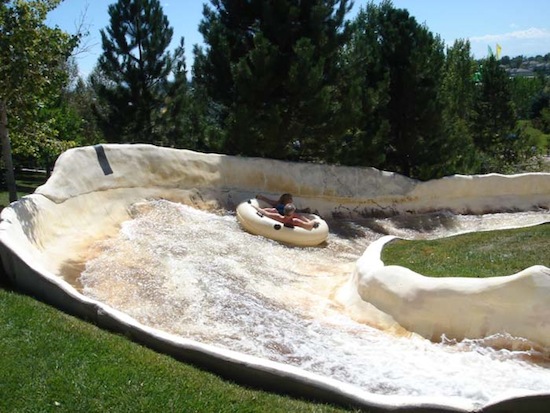
The layout of Water World is very confusing. It looks like it was expanded several times, and with the restrictions of its hillside location it can be very hard to figure out how to get to a certain attraction without one of the many maps that are found throughout the park. Even then, when you think you are on the right way to a certain water slide or food court, it is easy to get turned around by the doubling-back of some of the walkways. Several places had missing signs, where the entrance to two different attractions were signed for only one of them. The park is divided into several different themed "lands" such as "Big Top," "River Country" and "Wild Isle" but they all seem to just run into each other with no defining borders. It is a very attractive park visually, but not an especially efficient park to navigate, at least for a first timer.
Along with the before-mentioned water slides, tubes, etc., there are also two wave pools: Captain Jack's, which is the smaller and (I believe) the first wave pool at Water World, and Thunder Bay, a massive 1.8-million-gallon wave pool, larger than a football field. This wave pool is HUGE, and the waves it created were impressive. One problem, though, with this wave pool is that it is so large that it makes it a challenge to reach the entrances to several of the most popular attractions at Water World. The entrances are on the far side of the pool, requiring guests either to make a long detour around the pool or forge their way through the pool itself and the thousands of guests being tossed around (happily) by these massive waves. OK, I know, it's a water park and you go there to get wet, but our party of four decided to cross the pool (the most direct route) and were immediately separated by the surging waves, the dozens of inner tubes and countless happily shrieking guests.
We finally reassembled on the far side of Thunder Bay and after some more exploring found the entrances to the three most unusual attractions at Water World, "Lost River of the Pharaohs," "Voyage to the Center of the Earth" and "Storm." Each of these rides are family raft-type rides, requiring riders to carry their raft up a very long path to the entrance (unless they have paid for the Tube Valet wristband). These long climbs up the hill while carrying the large, awkward raft and waiting for your turn to climb aboard and start the ride is worth it. These water rides are fun, exciting, drenching, and unique experiences found in very few if any other water parks.
"Lost River of the Pharaohs" takes riders down a fairly smooth water channel that, I suspect, is meant to represent the Nile River. As the "river" twists, turns and gradually gains speed, an Egyptian pyramid appears and the river enters the structure. The riders in their rafts are suddenly surrounded by scenes from a Pharaoh's tomb, with mummies, ancient Egyptian statues, the Ark of the Covenant (for some strange reason known only to the designers and to Indiana Jones) and stone heads of Egyptian gods with eyes that begin to glow evilly. A voice announces that the riders have violated the Pharaoh's tomb and must suffer the curse, and the water channel suddenly gets much rougher — the speed of the rafts increases, the riders get splashed, and the channel begins to spiral down a helix deeper and deeper, finally emerging from the hillside and depositing the rafts into a landing pool, where riders exit their rafts and must make a decision- ride it again, or hurry over to the building next door, the queue building for the other major water dark ride at Water World, "Voyage to the Center of the Earth."
"Voyage to the Center of the Earth" is a wild, wet, completely indoors (and sometimes underground) family raft ride that takes riders through the well-known story of a recently discovered cave system that leads deep into the earth, where dinosaurs still exist. This unusually long water ride has unexpected drops, a wild, spiraling helix that carries rafts deep into the earth, and the occasional underwater baffle that stops the rafts completely in a calm pool, then sudden releases them into a rushing river. This river rages past bubbling pools of lava, through the skeletal remains of a huge creature, then carries raft and riders into an area inhabited with animatronic dinosaurs that snap, roar, and reach for the riders. Near the end of the ride a huge Tyrannosaurus Rex towers over the river, and the rafts barely escape by plunging down a tunnel towards the exit pool. This attraction is extremely popular at Water World, and deservedly so — it is great fun, very well designed and themed, and a ride that can be enjoyed over and over.
The third themed water ride is "Storm." It is themed to take riders through a torrential thunderstorm. It starts by sending the riders in their family raft through a drenching waterfall, then down a dark, winding tunnel where thunder, lightning and rain surround the riders, leaving them soaked and slightly thrilled. It is not as carefully or elaborately themed as the other dark rides, but it still was a fun adventure and unique in that it added special effects where most other water parks would just settle for a dark tunnel.
Other attractions throughout Water World have some general theming, such as the "Ragin Colorado" whitewater rapids ride, but most are the usual water slides, tubes, etc., all of which seemed to be well-staffed, well-maintained and attractively landscaped. There are several areas designed specially for children with such themes as the circus ("The Big Top") and the Caribbean ("Calypso Cove").
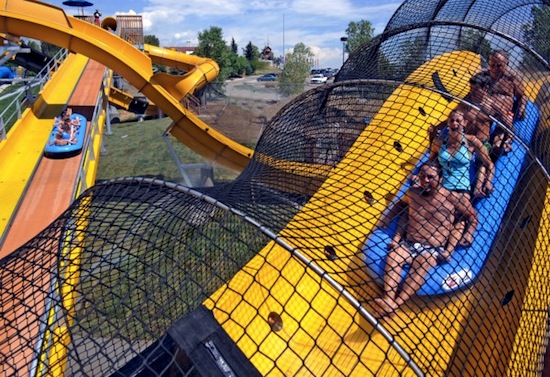
There is one attraction that approaches thrill ride status, "The Mile High Flyer," a hydromagnetic water coaster that uses linear induction motors to propel four-person boats at speeds of up to 20 mph. Dips, tunnels, boats being shot uphill and plenty of splashing water make this ride great fun. Unfortunately, this attraction is extremely slow-loading, and we waited for at least a hour for a two-minute ride.
Water World is a huge water park, with nearly 50 water attractions, restaurants and food courts, large sundeck areas and just about every amenity imaginable in a water park. We visited on a hot Tuesday in July, and there were thousands of people enjoying the water rides, the wave pools, the sun decks and large grassy lawns covered with beach towels. For some reason, though, the park is only open 10 a.m. to 6 p.m. We were there until closing time, and there were still thousands of people there enjoying the park. The early evening remained warm, and closing the park at 6 p.m. left many people disappointed — they wanted to stay and enjoy Water World longer. To get the most out of this park, plan on staying the entire day, open to close, and accept the fact that there is a good chance you will not be able to do everything there is to do there.
Water World. America's biggest water park. One of America's best.
Glenwood Caverns Adventure Park
Our day at Glenwood Caverns Adventure Park in Glenwood Springs, Colorado was one of the most fun and memorable experiences we had in Colorado. The drive from the Denver metro area to Glenwood Springs should almost be considered part of the "adventure." The three-hour drive on I-70 west from Denver passes through such well-known ski resorts as Vail and Breckenridge, but the best part of the trip is the magnificent scenery that surrounds the highway. The Interstate, reported to be the second most expensive highway in America, was designed to have as little impact on the topography as possible. In places the east-bound and west-bound lanes sit one lane above the other, to lessen the amount of damage done to the magnificent landscape of the Glenwood Canyon and the Colorado River that courses through it. Rafters can often be seen on the river, sometimes floating placidly on a level section, other times fighting raging rapids that make this stretch of the Colorado one of the most popular white-water rafting areas in Colorado. Towering mountains, rugged cliffs and an occasional waterfall make this drive an amazing experience, especially for a flatlander from Ohio.
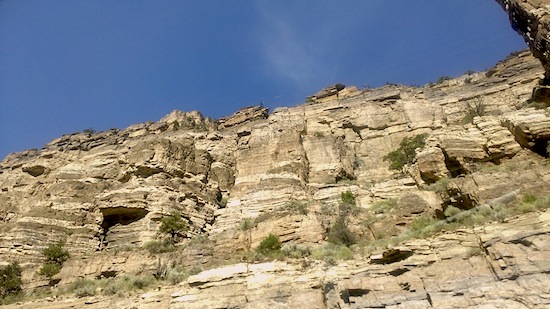
After seeing the signs for Glenwood Caverns Adventure Park and parking the car in a relatively small but free parking lot in front of a large hotel, we looked around. Where is the park? All we saw was a small ticket building and the loading station for a gondola cable car ride that crosses the road and ascends the side of a mountain. This is the gateway to the park, the Iron Mountain Tramway, a 4,300-foot tramway carrying a series of three enclosed gondolas, each capable of carrying six adults comfortably up the side of Iron Mountain to the park. This is not a continuously-loading skyride-type ski life, but gondolas arrive every few minutes, loading was efficient and the wait was minimal for us. Bad weather can close the tramway — in that case, shuttle buses carry visitors up the side of the mountain to the park (on a steep, winding road which many said was the scariest ride in the park!)
Glenwood Caverns Adventure Park is nearly invisible from the Glenwood Canyon valley. The entire park is on the top of (and in some cases inside) Iron Mountain, and the tramway ride offers magnificent views of both the surrounding mountains and canyons and, if you look down, the rugged vegetation that clings to the sides of these mountains. The climb to the top of the mountain only takes a few minutes, and the only thing to give any indication that there is something at the top of the mountain is an occasional glimpse of what looks like a roller coaster track hugging the hillside and a lone Native American teepee tucked in a small clearing, a very low-key attempt at theming, almost quaint in this era of extremely elaborate theme design at most "theme parks."
The tram drops guests at the Visitor Center, a three-story structure that contains both attractions and guest services. Passing by this rather non-descript structure (which I will return to shortly) guests find themselves in the Plaza, the center of Glenwood Caverns Adventure Park. This large open area is surprisingly attractive, and give visitors just a hint of the fun they are going to have at this remarkable park. The first things visitors see is the Mine Wheel, a small but uniquely-designed Ferris wheel that stands on a small hill across the Plaza and provides a beautiful backdrop and great welcome to the park. Also found in the Plaza, besides the Visitor Center, are the Snack Shack and Roundup Tent, where basic burgers, hot dogs, drinks and others fast foods can be enjoyed while watching live entertainment such as magicians and snake-oil comedy routines. Some craft shops and Guest Services are also found here.
The Visitor Center does not appear to be a very large structure, but it is filled with an amazing variety of attractions and services. The Main Level, entered from the Plaza, contains the General Store (with its usual and expected Glenwood Caverns/Colorado souvenirs), a ticket sales booth, and the Lookout Grille, a very large counter service restaurant with a limited but very reasonably priced menu and amazing views of the Glenwood Canyon far below. Seating is available both inside and from the surrounding dining deck outside.
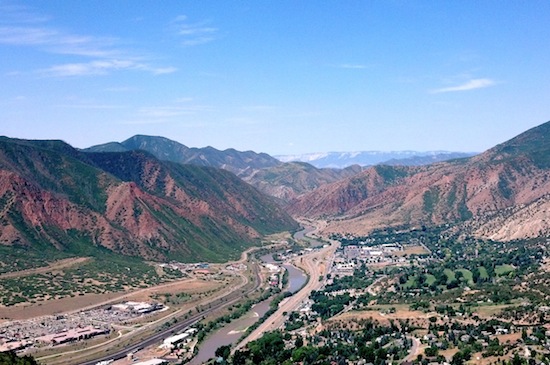
The Upper Level of the Visitor Center has a Laser Tag room, where about twelve guests at a time try to take out their opponents while hiding behind a variety of Wild West-type props (saloon bars, walls with windows, barrels, etc.). It was lots of fun, though not the largest laser tag facility nor the best, and the attendant we had was probably the only person we met at Glenwood Caverns who was borderline rude. Still, most guests seemed to enjoy the experience. The lower level of the Visitor Center, reached by walking around the outside of the building and down a path, housed the 4D Motion Theatre, the first in Colorado, where a trio of animated roller coaster-type short films were shown, with the usual moving seats, sprays of air and water, and other special effects. Great fun, even though Jeff Elliott insisted on screaming every time we went "down" a coaster hill and scared several small children in the theatre!
Before returning to the Plaza and discovering the rest of the adventure park, there are several small attractions on the path leading to the 4D theatre that need to be mentioned. This area is the best place to find adventures for small children. The Giddy Up, a small children's drop tower, and the Fossil Dig, a large shaded sand box, give young kids a chance have their own adventures and parents a chance to sit and rest. One of the most unique attractions I have ever seen anywhere was also found here, almost over looked by us because at first we didn't know what it was — the Speleobox. This was a large, wooden box, about 6'x6' high and wide and about 10' long, with two small openings in the front just large enough for a person who doesn't have much stomach on them to fit into. Inside there is a twisting maze of passages, strangely shaped openings, ramps, drops, and tight turns for children and adults brave (and thin) enough to attempt to negotiate and work their way through. The only way to get through is to crawl, push and pull yourself through on your stomach, back or side while bending, tugging and hoping that you can get through and come out the other opening. The idea of the box is to give you an idea what a spelunker (a cave explorer) must be able to do to explore underground caves and their tight, twisting passages. Both my son and Jeff managed to negotiate the Speleobox, although Jeff was a bit more winded and sweaty than my 14-year-old, barely 100 lb., son was. I admit it — I wasn't brave (or foolhardy) enough to try it.
Returning to the Plaza and heading down the walkway path to the right leads to several of the signature attractions of Glenwood Caverns Adventure Park, the first of which is the Fort WhereAmi Maze, a large wooden fort maze where the goal is to find your way to all four corner towers and escape before your friends do. Each explorer is given a paper where they can write down the time they start the maze. Each corner tower has a paper punch chained to the wall, with a different letter punch in each corner (spelling M-A-Z-E when you reach all four towers) that you use to prove you found each tower. Then you need to find your way out of the maze, and compare winning (or losing) times. It is a fun maze, challenging, sometimes frustrating and well worth the effort.
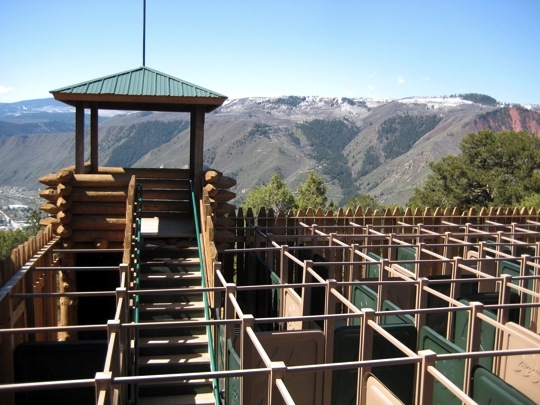
The next attraction on this pathway is the Giant Canyon Swing, a power swing by S&S. I will admit that I did not ride this attraction. I bravely held our places in line for the cave tours while Jeff Elliott and my son Anton researched the Giant Canyon Swing. This is the report Jeff brought back:
"The swing is perched on the edge of a cliff, not a pretend cliff or close to a cliff, but right on the edge. The brave will choose the seats that face toward the mountain and once the swing ride gets going, you are looking straight down 1300 feet to the highway and canyon river that you arrived on. Even for a jaded roller coaster junkie who has laughed on Top Thrill Dragster, this simple swing ride took my breath away and had me repeating in my mind 'I trust the ride. I trust the ride. I trust the ride.'… which for some odd reason kept me from screaming a blue streak. The actual ride is not that tall (fifty feet tall with a maximum arc of 122 degrees) but it is just tall enough that you lose track of the land surface you started on and can only look down on 1300 feet of oblivion. For someone scared of heights, the walk on the platforms just to get to the swing will probably be enough to make you turn back. Just for color on the size of the drop… think about four Top Thrill Dragsters stacked on top of each other… and then swing off the edge to the point that you are slightly more than looking straight down."
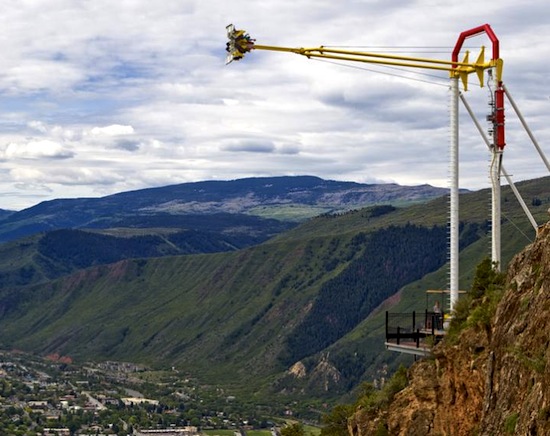
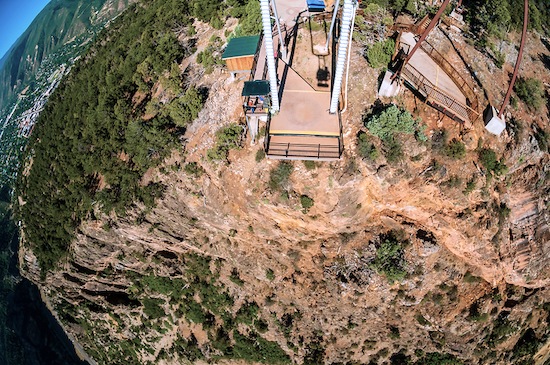
The remaining attractions on this pathway are the reason that this park was created in the first place, the caverns. There are actually two cave tours, the Historic Fairy Caves and the King's Row Caves. The Fairy Caves were the first caves discovered in the late 1800's, and were open for tours in 1897 as one of the first cave tours in America with electric lighting. This cave tour has been expanded and lengthened to a 45-minute, quarter-mile guided tour by an experienced guide. The second cave tour, King's Row, is a portion of the same cave complex but lower down the hillside. It is also a 45-minute guided tour, and includes a rather remarkable light show deep in the cavern complex showing the luminescence of some of the minerals that created this cavern system. Neither of these tours is handicapped-accessible, and require guests to climb up and down many steps and pass through multiple narrow passages. Both, though, are remarkable adventures, well worth the visit. I have been in several cavern systems before, but never on the top of a mountain! The guides were friendly, intelligent, experienced and made the tour interesting for all ages.
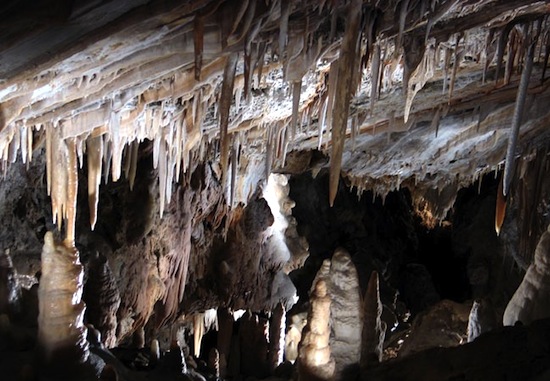
Returning to the Plaza and following the pathway to the left leads to some of the most thrilling attractions at Glenwood Caverns. On the right hand side of the path is a wild west "Shootin' Gallery", "Olde Tyme Photos", a rock climbing wall, the Wild West Express family coaster, and three of the signature attractions in the park, attractions that put the "adventure" in Glenwood Caverns Adventure Park: "Cliffhanger", "Soaring Eagle" and "The Alpine Coaster."
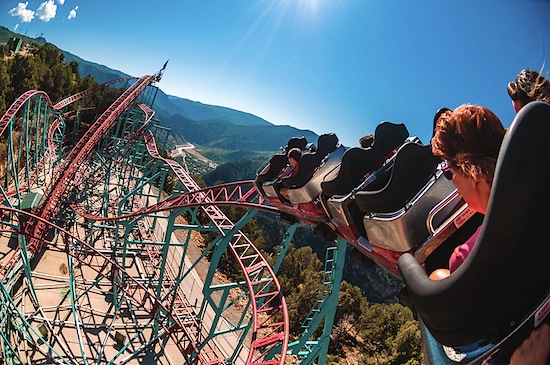
The Cliffhanger Roller Coaster started its life as Firestorm at Celebration City in Branson, Mo. It was sold in 2012 to Glenwood Caverns, where it was renamed Cliffhanger for a good reason — it sits on the edge of a cliff 1,450 feet above the Colorado River, and with its elevation of 7,160 feet above sea level it hold the record of being the highest coaster in elevation in North America and one of the highest anywhere in the world. It is not a spectacular coaster in itself, being a fairly small steel coaster with some wicked turns, but the scenery surrounding it, especially as you are racing along the edge of the cliff and looking down at the river makes a ride on Cliffhanger a thrilling and memorable experience, one well worth the long climb up the winding path to the hilltop where it stands.
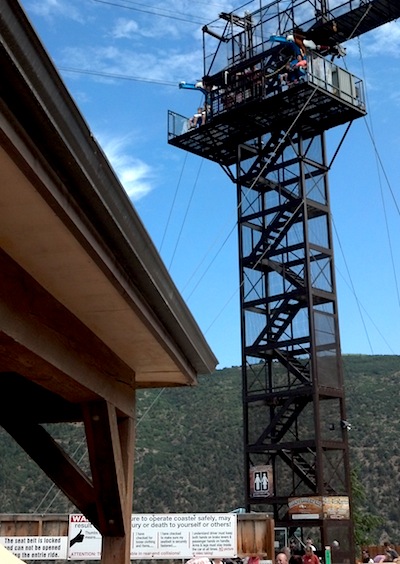
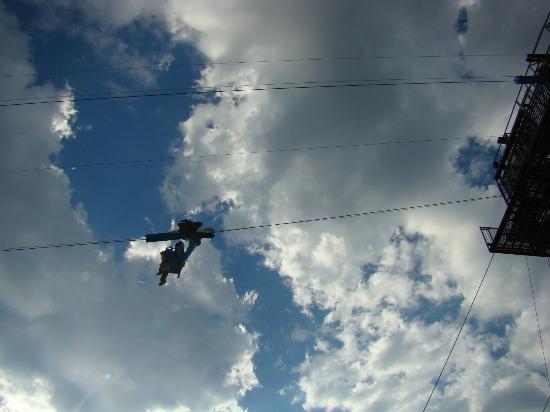
Soaring Eagle Zip Line sends riders down a 625-foot cable while seated in a ski lift-type chair with an eagle design motif. Riders must climb a winding staircase to the top of a metal tower, where they are secured into their seats, the safety rail in front of them is pulled back, and they sail off down the cable towards the Glenwood Canyon far below. Upon reaching the bottom of the cable and stopping thanks to a series of springs, they are winched back to the loading station. The ride is not especially long, but does give a bit of an adrenaline rush, especially for guests with a fear of height.
The signature attraction at Glenwood Caverns Adventure Park (after the actual caverns) is the Alpine Coaster, the first of its kind in America. Riders are secured by a seat belt (which cannot be unlocked by the rider) to a sled capable of holding two adults (but single riders were the norm when we were there, other than for young children being required to ride with adults). These sleds are attached to a 3,400 foot long track that weaves back and forth down the side of Iron Mountain, with tight banked turns, bumps, waves, and straight-a-ways that let the rider-controlled sleds reach speeds of nearly 30 mph (although one employee told us that, for employee nights, the built-in brakes can be removed and speeds of over 40 mph have been reached, making Jeff Elliott wonder how to get a job there!)
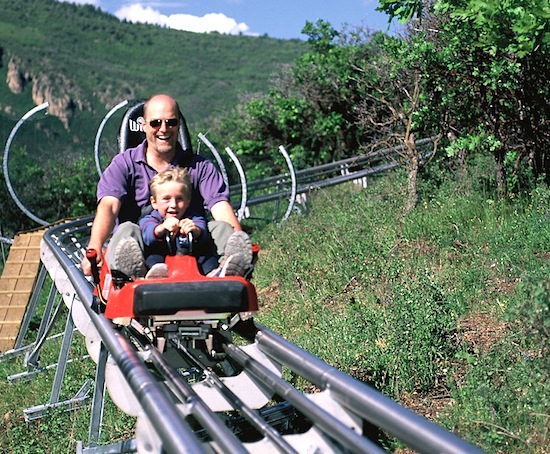
Upon reaching the bottom of the track, the sleds and riders are winched back to the loading station up a 1,000-foot track that lets riders relax from their heart-pounding descent and enjoy the rugged vegetation, bushes, wildflowers and weather-beaten trees that cover the hillsides at this altitude. The Alpine Coaster is an attraction that anybody who gets the least bit of enjoyment from a roller coaster should absolutely NOT pass up! It is exhilarating, breathtaking at times, and a unique experience that gives riders a chance of being the only rider on a roller coaster that they are in control of.
Glenwood Caverns Adventure Park is not a very large park in size. When we first arrived, I thought that it was a cute little park with a typical western theme, a park with a limited number of attractions that would probably keep us entertained for half of the day. What I found was a full-day park with an amazing mixture of adventures, family attractions and thrill rides, a park with experiences that almost beg to be repeated over and over because they were so much fun. Some guests with limited time purchased individual tickets and only did a few attractions, while others, like ourselves, bought Fun Day Passes ($48/adult, $43 /children 12 and under). The Fun Day Pass was by far the best purchase for us — we did just about everything, often multiple times, and wished we could have done more. Glenwood Caverns Adventure Park is an amazing park, a treasure in Central Colorado that deserves to be discovered by anyone who loves adventure and family fun.
The Wild Animal Sanctuary
On the prairie about 40 miles northeast of Denver, near the small town of Keenesburg, Colorado stands one of the most remarkable facilities to be found anywhere in the world. It is not a theme park — there are no rides, no roller coasters, no flat spinners. It is not a water park — although there are pools and some waterfalls, swimming in these pools is not only prohibited, but is downright dangerous and potentially deadly. The nearest mountain range is 50 miles to the west, beautiful in the distance, but the landscape between them and this facility is mostly flat and featureless, covered with scrub grass, scraggly bushes and rocky dirt. It looks like the Serengeti of Africa — windblown, dry, almost barren...and it is the home of one of the most fascinating experiences we had during our visit to Colorado.
This is The Wild Animal Sanctuary.
The first thing that must be understood to fully grasp the importance of this place is that it is NOT a zoo. It is not a place designed to keep visitors entertained with exotic animals on display in carefully-themed enclosures. The animals, their needs and well-being, come first — always. That is not to say that the human visitors to TWAS (the abbreviation which is used in all official publications and that I will often use to save time) are ignored. On the other hand, visitors are provided with an amazing variety of information about these animals, both in general and concerning each individual animal, their stories, what brought them to TWAS, and what we can do to help them and prevent their stories from being repeated with other wild animals. The facilities provided for visitors are basic — a few food stands, a gift shop, port-a-potties — this is not a fancy place. It is a place to learn, to understand, to experience.
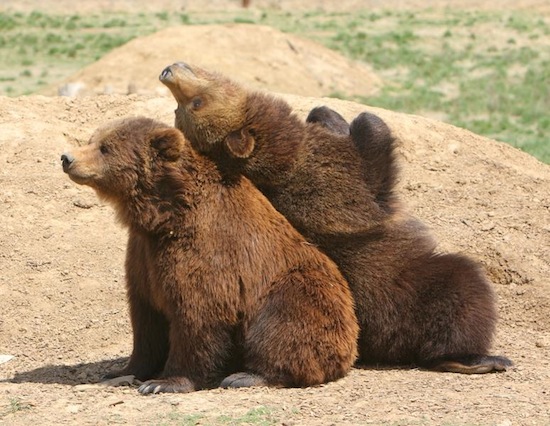
The Wild Animal Sanctuary was founded in 1980 by Pat Craig, who opened a licensed facility on his farm near Boulder, Colorado to take in a Jaguar cub. Soon his mission of providing a place to care for and rehabilitate large carnivores was established, and he moved to larger facilities in Lyon, Co. Development in the area forced TWAS to relocate to its present location in 1988. Financial difficulties due to decreased donations in 2005 nearly led to the closing of the facility, but in mid-2006 it was decided to aggressively raise the needed funds by opening the facility to the public for the first time, increasing the use of volunteers, soliciting sponsors and selling merchandise. Since then, visitor attendance to TWAS has reached the 100,000-per-year mark, and the facility has expanded its area from 320 acres (160 acres dedicated to animal habitats) to 720 acres, with nearly 400 acres of habitat available and plans for future expansion of habitat areas into the future as funds are available and needs are determined.
Pat Craig, the Executive Director and founded of TWAS, stated, "Our organization exists to rescue and provide a permanent home for wild animals that have been abused, abandoned, displaced or neglected. The vast majority of the animals residing at the Sanctuary were either confiscated by law enforcement, or seized through some type of legal action against people who attempted to keep a large carnivore as a pet." There are a few exceptions to the large carnivores that dominate the population of TWAS — a herd of fifty Alpacas were donated by their owner who could not afford to feed them anymore and offered them to TWAS to "feed to the tigers." TWAS accepted them, but instead of using them for fresh meat, the Sanctuary provided them with pasture, food, security and the companionship of several donated horses and even a rescued camel, Morrison.
The vast majority of animals at TWAS were bred in captivity, and are unable to fend for themselves in the wild. They do not know how to hunt and survive on their own, having always been fed by humans. The goal of TWAS is to rehabilitate these magnificent creatures, return them to health, acclimate them to their new surroundings and to other similar animals, and let them live out their natural lives in surroundings as close to their native homes as possible. When they first arrive at TWAS and are evaluated for their needs, they are kept in small enclosures (which are still usually much larger than the crates, small pens or wire cages where they spent most of their previous lives), then gradually introduced to others of their species. A proper diet, medical treatment for the many conditions they always seem to suffer from, and a healthy, stress-free environment help these previously-abused creatures become the majestic animals they deserve to be. There is no attempt to retrain them to be returned to the wild, since for most of them the wild would be a death sentence. The Habitats created at TWAS attempt to let them live safely in a setting close to what their lives would have been like had they been born in the wild, without the dangers they are not prepared to face.
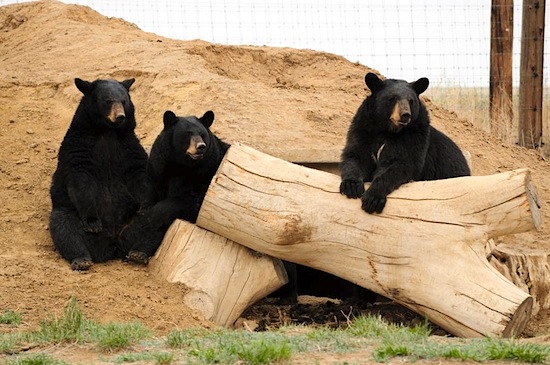
These Habitats at TWAS are huge. Depending on the type of animal living there, they range from five to 25 acres. All have underground dens of concrete that maintain a temperature of about 60 degrees year round, thus allowing the animals a place to go and have some privacy; shaded shelters and play structures are found throughout the habitats, and pools and water tanks are plentiful for those animals who like to play in the water and cool off. A few animals are kept in smaller enclosures if they have special health needs and being in the larger habitats would not be in their best interest, or if they are new arrivals and are still being evaluated and rehabilitated, but they still have all the benefits of privacy, a healthy diet, security and mental stimulation that make their lives at TWAS enriching and satisfying.
It was soon recognized that visitors to TWAS wanted to see these animals as close as possible, but how to do so without putting them back in the same situation they often came from, that of being "on display" and forced to perform for the humans? It was discovered that these animals do not consider anything above them to be "territory." The answer was one of the most original structures in any animal facility in the world, the "Mile Into the Wild Walkway". This concrete, steel and composite walkway is 22-feet wide, approximately 30 feet above ground and an amazing 4,800-feet long. It is fully handicapped accessible from the Welcome Center via a ramp, and traverses over 21 of the large animal habitats while connecting the Welcome Center to the Tiger Roundhouse and Education Center, the Central Observation Deck and the Bolivian Lion House. Future plans include the development of more Habitats, with the Mile Into the Wild Walkway being extended to a total length of over 15,000 feet — nearly three miles!
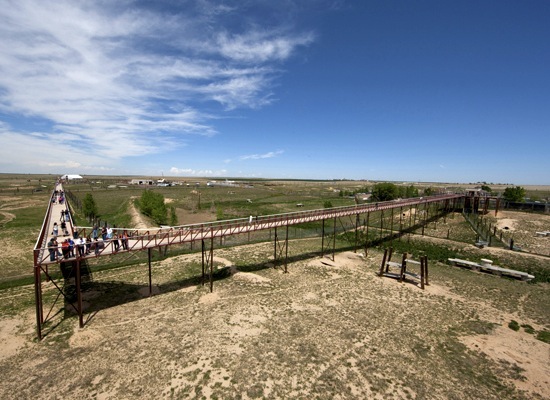
Every animal at TWAS has its own story, and these stories are shared with visitors in a variety of ways. The Tour Guide Book, available at the Welcome Center, gives detailed histories of nearly each animal at the Sanctuary. The Education Center, located near the beginning of the Walkway, has displays showing how many of these animals found their way to TWAS, including some actual footage of them being rescued from often horrible situations. Volunteers are often found walking with visitors on the Walkway, telling them about TWAS and it mission, and relating to them something about each animal in the habitat below. They know these creatures by name, and it is obvious in a few minutes that these volunteers take great pride in the work that they and the hundreds of other volunteers do in caring for these majestic animals.
What happened to bring these wild animals to this amazing facility? Each has their own story, and each story is worth knowing. These are just a few of them, quoted from the Tour Book:
"Irwin (Tiger): This Tiger came from an El Paso Texas truck stop where he was a roadside attraction. The Tigers there were allowed to breed at random, and their cubs were sold to motorists who stopped to get gas."
"Sandy (Mountain Lion): Sandy was owned by a Texas family who hit her on the side of the head with a baseball bat. She suffered skull fractures and damage to her right eye."
"Mara (African Lion): Mara used to be in the film industry in California. However when she reached roughly the age of two, Mara chose to stop cooperating with her trainers- and so she was discarded."
"Magnum (Black Bear): Magnum and three other Black Bears were rescued from a small property in Dayton, Ohio after their owner died suddenly. The Bears spent 20+ years of their lives living in tiny horse stalls with concrete floors. They were also declawed and had their teeth filed down because they were trained to perform tricks and wrestle people at local fairs."
These are just four of the hundreds of stories that these animals brought with them to TWAS. Here, they are allowed to live as close to a normal life as possible. Visitors looking down at them in their habitats will see lions, wolves, tigers, leopards, black and grizzly bears, foxes, bobcats and even lynx and African servals, all living like they should — not on display in a roadside sideshow or performing in a circus in Mexico, not locked in a horse trailer in Oklahoma or being kept by a drug lord in Chicago (all of which has happened to some of these animals) but enjoying life. The lions have formed Prides, the wolves live in packs, and the Grizzly Bears — well, when we were there, each had claimed a large metal water pool to bask in, soaking in the cool water like it was their own private Jacuzzi. As evening approaches, the wolves begin to howl, the male lions start to roar, and the cooler temperatures encourage the animals who have spent most of the day basking in the warm sun to start playing, exploring, and showing the hundreds of visitors strolling on the Walkway just how important this place is.
TWAS does no breeding of animals. All animals are spayed, neutered or implanted with contraceptives — with the exception of male lions. Neutering a male lion would cause the loss of their manes, which are directly related to their testosterone levels, so all female lions are implanted with contraceptives. Except for the rare instance when a rescued animal was pregnant when it arrived, TWAS does not deal with infant animals. When that does happen, though, arrangements are made to care for them and eventually integrate them with the current population of the Sanctuary.
The Wild Animal Sanctuary survives on donations, admission ($15/adult, $7.50 children 3-12), merchandise sales, sponsorships of animals and portions of the Walkway, and other fundraising enterprises. It is open year-round, with hours varying depending on the length of the day (9 a.m.-8:30 p.m. during some long summer days, 9 a.m. to 4:30 p.m. during some shorter winter days). The website lists hours.
Is this a full-day activity? Probably not, unless you have a major interest in large wild animals. However, you will be surprised how fast several hours can go by while you discover how these animals live in their natural settings. Plan on between two and four hours to fully experience TWAS, preferably later in the day when the temperature is cooler (in the summer at least) and the animals become more active. There are two things that you should consider bringing with you to get the most out of this experience — binoculars and a camera with a zoom lens. The walkway is at least 30 feet above the ground, and the habitats are up to 25 acres in size. The animals go where they please — they are not herded into up-close-and-personal enclosures to be sure that visitors get the best view. They decide where they want to roam, sleep, lounge, and occasionally hunt the hundreds of rabbits that share these habitats with them, and sometimes they decide to hang out quite far from the walkway. The binoculars can come in handy at these times, but even if you don't bring them, not to worry — the animals in the next habitat will probably be closer, and TWAS put many of the enrichment facilities (water tanks, trees, shade structures, etc.) near enough to the walkway to keep the animals easily visible to guests.
The Wild Animal Sanctuary in Keenesburg, Colorado is a fascinating place to explore. Visitors will see wild animals in a setting like no other — animals living in habitats as close to their natural environment as is possible, where human intervention is limited and the animals and their well-being comes first. It is a remarkable place to visit — calm, relaxing, interesting, and educational without being heavy-handed about it.
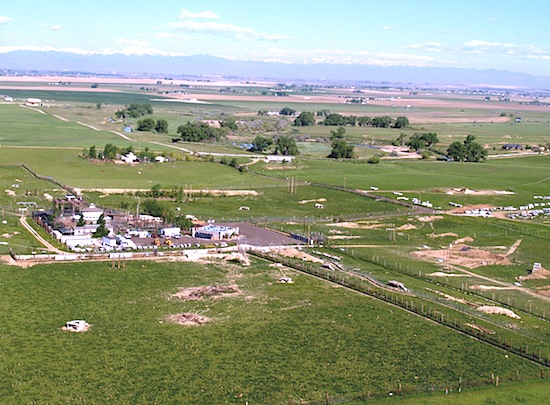
It is an important place. It deserves our support. If you find yourself anywhere near the Denver area, take the time to spend a few hours at The Wild Animal Sanctuary. It was one of the highlights of our visit.
Tweet
Elitch Gardens: I've always been interested in Elitch Gardens simply because it is the biggest park in the Rocky Mountain area, but after reading what you wrote it sounds like little more than a credit stop. Interestingly, it reminds me a lot of a park I visited last year: Darien Lake. Both parks share some history, as they were purchased by Premier Parks, became Six Flags properties, got sold to PARC Management, and are now run by Herschend. Service was pretty poor at Darien Lake, with one train operation on coasters despite 45 minute waits and a number of breakdowns. Unlike Elitch Gardens, however, Darien Lake does have an outstanding coaster in Ride of Steel (the first Intamin Mega Coaster), although the rest are average at best. Perhaps it was because my only other experience with Herschend was at Dollywood (an outstanding park) but I came away from Darien Lake disappointed.
Also, before I move on, here's some more information about the Mind Eraser comment from Part 1: The Mind Eraser coasters were installed by Premier Parks in the mid/late 90s. Five total were built, all of the standard Vekoma SLC model (25 of which have been built to date). Darien Lake, Elitch Gardens, Geauga Lake, Six Flags America, and Six Flags New England all received one of these coasters. Today, four of them still operate at their original locations under their original names. The Geauga Lake installation now runs at Michigan's Adventure instead under the name Thunderhawk (a name it received when Cedar Fair purchased Geauga Lake).
Lakeside Amusement Park: This certainly sounds like the better of Denver's two amusement parks, even if it is a little ghetto. It doesn't sound like a full day park, but would be fun for a half-day or so (perhaps Elitch and Lakeside could be done on the same day). Cyclone looks like a pretty good coaster (especially for its age), and that tunnel of love beginning exists on the only other remaining Vettel coaster as well (Conneaut Lake Park's Blue Streak, which I got to ride last year).
Heritage Square: While I've heard of this place before, I knew very little about it before reading this report. It sounds like a fun place for families to spend some time, although other than the Alpine Slide nothing is really thrilling (by the way, James, still think the alpine slide from my TPA 4 park could never happen?). Still, it would be fun to visit just to see the place, as from the pictures it looks like the theming quality is excellent for a small park.
Water World: Of all the parks in Colorado, this is the one I most want to visit simply because of its unique attractions. Lost River of the Pharaohs, Voyage to the Center of the Earth, and Storm could each be placed into almost any waterpark and instantly become that park's best attraction, and everything else seems among the best of its type. It's a shame that the hours make it impossible to do everything in a day, but I guess that would just give reason to return.
Glenwood Caverns Adventure Park: This place is a bit of a trek from Denver, but it sounds like it's worth it. I didn't realize there was so much to do here and thought it would be a place good for a couple hour stop if passing by, but from what you described it certainly sounds like you could easily spend a good part of a day here without getting bored. The Alpine Coaster sounds better than the one I rode in Park City and although I don't usually get scared by rides, the Giant Canyon Swing would certainly give me second thoughts. Yes, they've got a normal roller coaster, but compared to all the unique attractions and the cave tour it sounds like Cliffhanger is one of the least interesting rides.
The Wild Animal Sanctuary: Unlike the other places mentioned, I had never heard of this place until reading the report. This sounds much better than any zoo out there, and although it kind of reminds me of the San Diego Safari Park it seems very different and a lot more unique. While I'm not a huge animal person, if I were in the area and time permitted I would definitely want to check this place out.
Thanks for this great report.
I have to say though, that Elitchs was not for the better. I have not been there in...5+ years and even when I went, it was just dirty, and no fun. It's sad to even think that it may be just a ghost park in the next 15-20 years if the owners can't turn it around and hype it back to what it used to be.
Water World on the other hand...I LOVE it. Sure, it's not fun to have to carry your OWN tube to the tops of the rides, but at least you know you'll be getting wet and cooling off on your way back down. I worked there for 7 summers and enjoyed my job. They hire some of the best teens in the state and I find, even know, great customer service. As for Mile High Flyer and the wait time, it opened last summer, and I'm sure they're still working out SOME kinks...so you have to give them a break on the loading times. Not to mention, I'm sure other water parks with water coasters faced the same slow load time in the beginning as well. Give it time, it'll get better. :)
Interestingly enough - at least for me - I heard of the Glenwwod Caverns Adventure Park for the first time earlier today on the Travel Channel's Ride-alicious. I think that's how they spelled it, but whatever - it's a madeup word to begin with. From what I saw on television, those pix supplied by the park don't do it justice. But also doesn't seem to be especially accessable.
The Wild Animal Sanctuary also reminds me of the San Diego Wild Animal Park. No, NOT the Safari Park. If it ain't broke,...
And I'll sign off before I start to REALLY rant on that. :-)
I can't express how disappointed I am with Herschend for not getting Elitch Gardens turned around at all, but in their defense, it is difficult to change a culture as bad as the one in that park. Furthermore, who knows how much money they are allotted for improvements, maintainence, and training? PARC is a lousy parent owner and their parks, pretty much across the board, are crap. As I sit in my hotel room getting ready to go to Silver Dolllar City in Branson, MO, I am keenly aware of what Herschend is capable of doing when they have the latitude and budget to do it right. One can only hope a new owner steps in and Elitch Gardens is given the love and attention it deserves.
And one last thing... I miss Celebration City and my fun, little Firestorm coaster. Tell Glenwood Caverns we want it back! ;)
Again, thanks for sharing James (and Jeff), you made my morning. Now off to SDC and OUTLAW RUN!!!
Ghetto for LS?! Lol! NW Denver is hot! And houses now cost a fortune! 20 years ago, ghetto, now gentrification hell.
But to be honest, the tiny little "town" of LS is trashy and rundown because the woman who owns all the property does nothing to fix or maintain. All the houses along that strip on the westside of Sheridan are owned by that person also. Awful and rundown, where houses going for 500+ are only a few blocks away.
Did you notice the ramshackle racetrack South of the amusement park? A car went into the stands in 88 and debris went all over into the crowd. That speedway should have been torn down years ago- it is a hazard. In any other place it would have been. But b/c it is in LS and mot Denver or Wheatridge, it still is there. Owned by that same person. The land where Lakeside mall used to be is being completely wasted. Also, don't speed on 44th between sheridan and harlan! Ticketing speeders is LS's main source of revenue (same for nearby Mountain View on harlan btwn 44th and 38th.
This article has been archived and is no longer accepting comments.
My family in Colorado also labeled Lakeside Amusement park as ghetto and discouraged me from visiting.
On the contrary, I visited Waterworld this past summer and really enjoyed it! Voyage to the Center of the Earth, the Zoomerang, and the Mile High Flyer were all really fun! Sun burns also seemed to be a problem at the higher altitude...I ended up having to rotate myself like a roast while waiting for the Mile High Flyer.
Glenwood Caverns and the Animal Sanctuary will definitely be at the top of my list for my next visit to Colorado. The only zoo with exhibits near the Sanctuary's size in Georgia is Oatland Island, while Zoo Atlanta has by far the smallest animal habitats I've seen. Any love for the Denver Zoo or Cheyenne Mountain zoo?
Thanks for the great trip report!